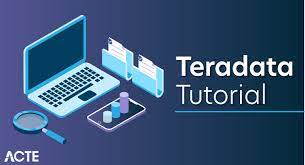
TERA DATA TUTORIAL
TeraData is a Relational Database Management System that is used to extract various types of data from multiple sources and converts, integrates and stores large scale data in a single place and in a common format and its data Consolidation make data available for analysis. The one of the biggest strength of the Teradata is the parallelism.
Training Objectives of TeraData:
Teradata is an enterprise software company that develops and sells a relational database management system (RDBMS) with the same name. It enables users on a workstation to easily access one or more Teradata Database systems for ad hoc queries, report generation, data movement and database administration.
Target Students and Prerequisites:
Students must be belonging to IT Background and basic Understanding Relational Database Management concepts.
Teradata Architecture and Components
PDE(Parallel Data Extension)
Vprocs (virtual processors)
PE (Parsing Engine)
AMP (Access Module processing)
Board less Bynet
TDP (Teradata Directory Program)
CLI (Call Level Interface)
TPA (Trusted parallel Application)
Going in depth by explaining the process of SQL statement execution
Various Architecture
Node Architecture (shared nothing)
SMP Architecture
MPP Architecture
Parallelism Architecture
Benefit & types
Data Recovery and Protection
Object Locks-Various locks for simultaneous access
RAIDI
RAIDI5
Disk Arrays
Fall Back
Clique
AMP Clustering
Journals
Teradata Storage and Retrieval Architecture
Request processing
a. Syntaxer
b. Resolver
c. Security Module
d. Optimizer
e.Step Generator
f. GNC Apply
g. Dispatcher
Primary index
1.Hash algorithm
2. Row hash
3. DSW
4. Hash Map
5. Hash Bucket
6. Reaching Vdisk
Teradata Indexes
Primary Index
Unique
Non unique
Partitioned
Secondary Index
Unique
Non unique
Hash, Join, Value Ordered
Skewness
Secondary Index Sub table
Accessing Records via primary index
Accessing records via Secondary index
Keys vs indexes
Teradata Sql Reference
Fundamentals
Data Types and Literals
Data Definition Statements
Data manipulation statements
Teradata Functions and Operators
String functions
Format functions
Cast functions
Group & Aggregate functions
With & with by clauses
Teradata Transactions
Implicit Transaction
Explicit Transaction
Performance Tuning and Explain Utility
Explain Usage
Collection Statistics
Tuning SQL Performance
Usage of PMON
Joints & Unions
Inner Join
Left Outer Join
Right Outer join
Full Outer Join
Teradata Basic Commands
HELP
SHOW
EXPLAIN
COLLECT STATISTICS
Teradata objects
Tables
1. SET table
2. Multi Set table
3. Volatile tables
4. Global Temporary tables
5. Derived tables
Views
Macros
Stored procedures
Triggers
Teradata spaces
PERM space
SPOOL space
TEMPORARY space
Teradata user and managing.
Teradata Transaction Modes
BTET
ANSI
Interactive
Batch
Load and Unload Utilities & Tools
Teradata Sql Assistant (Queryman)
Teradata Performance Monitor
Teradata BTEQ
a. Batch Scripts with samples
b. Branching and Looping
c. Importing data through scripts
d. Exporting data through scripts
e. Session Control Command Set
f. Error handling.
Teradata Fast load
a. Various Phases of Fast Load
b. Advantages and Process
c. Limitations of Fast Load
d. Sample scripts
Teradata Multi Load
a. Various Phases of Multi load
b. Limitations of Multi Load
c. Working with multiple tables
d. Applying various operations
e. Sample Scripts
Enroll For Course Now